If you follow Italian football and always seek young, innovative coaches in football with distinguished vision, the name of Roberto De Zerbi probably comes quite high on the list. The 41-year-old coach is currently in charge of Sassuolo in Serie A and breaks all the rules in modern-day football ruled by money and extreme transfer policies.
While he had some unsuccessful spells with Palermo and Benevento, his interesting tactical approach has earned him a place at Sassuolo, where he managed to transform the team that had previously wandered in the lower leagues into a Serie A title contender in the 2020/21 season. The team are moving around the top along with Milan, Inter, Napoli and Juventus.
The Neroverdi are one of the most exciting teams to watch in the last couple of years since De Zerbi’s arrival in 2018. Most of their games end up being spectacular with a lot of turnovers and goalscoring opportunities. The Italian’s clear tactical vision has drawn the interest of many coaches who have praised him for his work, with Pep Guardiola giving his nod of approval on his team’s contemporary attacking style of play.
We will use tactical analysis to examine De Zerbi’s tasteful tactical decisions and give an insight into his vision and Sassuolo’s style of play. The analysis will give an in-depth look into the team’s tactics in each phase.
Roberto De Zerbi’s coaching style
As mentioned, the Italian is very particular in his requirements and wants to see his teams play in a certain way and nothing less. He always tries to adjust his players’ abilities to his strategy and get the most out of both, but he wouldn’t change his principles for the sake of putting certain players under the spotlight. Despite the high reliance on Ciccio Caputo in attack, De Zerbi stays away from creating one-man teams and focuses on creating a connection that will be followed by fluidity and successful actions.
He aims to build a dominant team that displays possession of football and controls the game mostly in the opposition half. Relying on a lot of movement and short passing his teams always focus on building up from the back and smooth ball progression towards the overcrowded advanced areas where he has deployed as many players as possible. He wants his team to have control on and off the ball.
He might adjust the starting XI according to the opposition, but he never stays away from his style of play and always relies on his usual tactical approach in aim to expose the opponents.
Currently, his favoured formation is 4-2-3-1, which is used to improve coverage and width. One of the full-backs of the four-man defensive line would always help with ball progression, while the advanced wide players would be used as inverted wingers. That is one of the most important traits of his team since he achieves width and has players who constantly occupy the penalty area and act as a direct threat. While he wants to have coverage out wide, Sassuolo rarely relies on crossing in their attacking actions. Instead, they use the width for their build-up and then focus their actions in the central areas from where they create most of their opportunities.
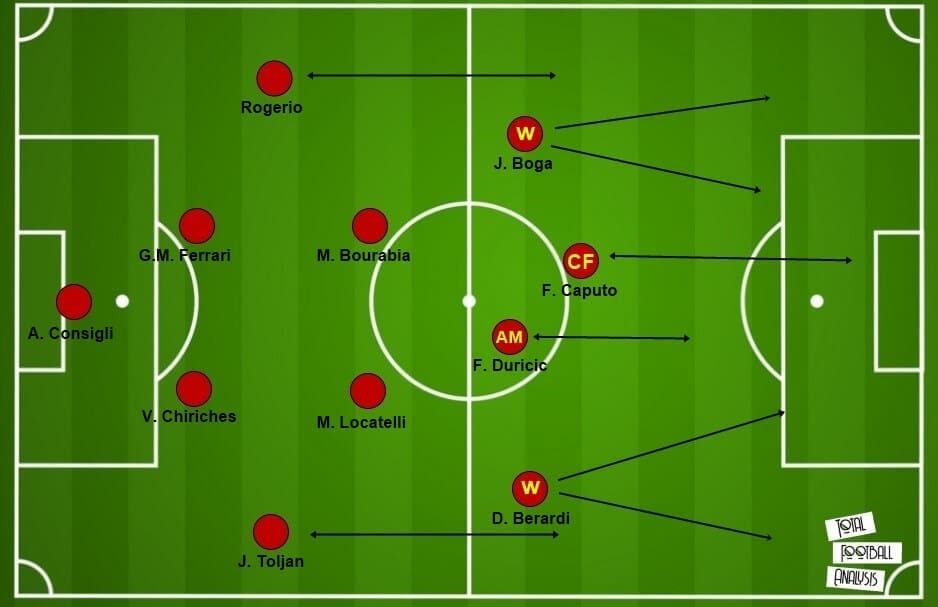
Even more impressive trait of his coaching style is the way he unlocks the players’ potential. The level of improvement many players have achieved under his guidance is extraordinary, and that is why he is a difference-maker. Managing to perform at that level with Sassuolo’s limited involvement in the transfer market is what makes him one of the most exciting coaches of this generation.
Dominance and movement in ball progression
Sassuolo are a team that highly rely on possession and passing in aim to control the game and allow the opposition less time on the ball. They prefer circulating the ball using short passes and very rarely rely on long balls and direct play in order to advance the ball. The team are third in Serie A when it comes to pass frequency but what is more impressive is their confidence on the ball and the fluidity they achieve. They are the team with the highest pass accuracy (90%) in the league, which is one of the reasons for their efficiency.
They always aim to build-up from the back by circulating the ball between the four men in defence and the double pivot in midfield and then smoothly transition using short pass combinations and a lot of movement for advancing the ball. Manuel Locatelli would often be the key man in ball progression, averaging 77.83 passes per 90 with 90% accuracy in aim to support his team’s attacking actions and deliver the ball to the advanced areas.
Not only does he help bypass the opposition’s pressing systems early on, but he’s also key for delivering the ball to the advanced areas, where he contributes with 14.65 passes to the final third. Only Arturo Vidal and Marcelo Brozovic from Inter have better records in that indicator.
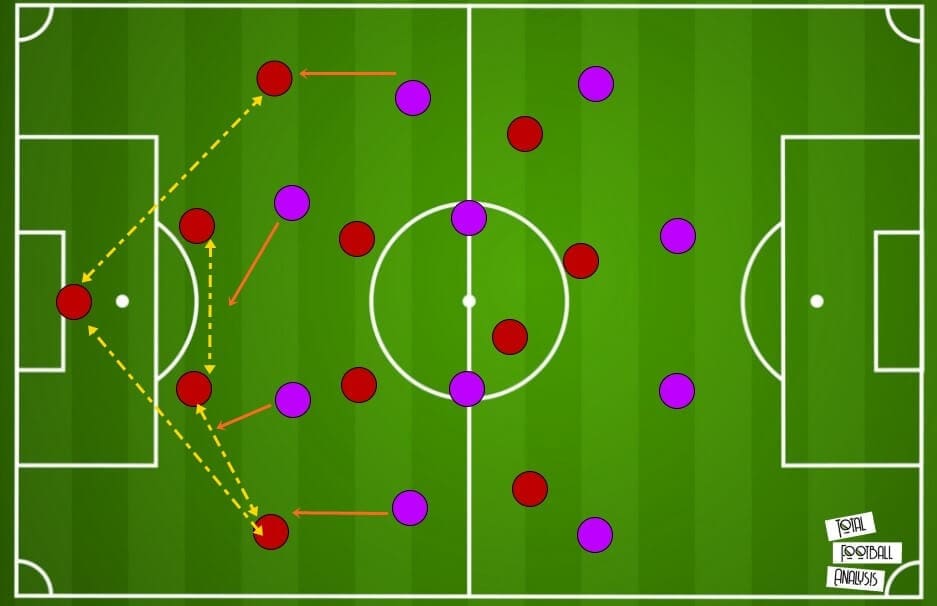
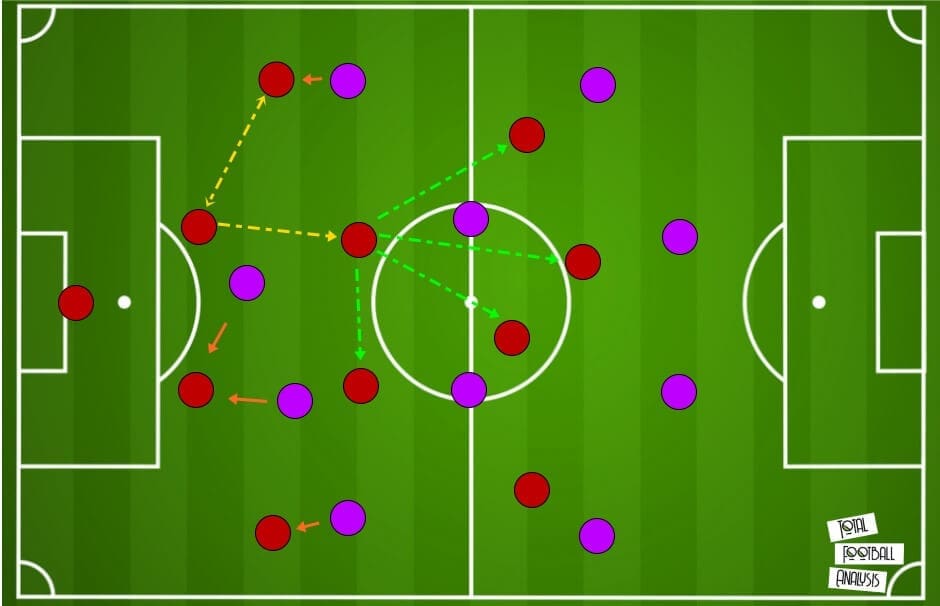
What makes him that important in De Zerbi’s set-up is his unusual use of the 4-2-3-1 scheme. While the teams using that formation often rely on the full-backs’ support upfront, the Italian has transformed that set-up. While helping with retaining possession and with ball progression, Sassuolo’s full-backs wouldn’t go too high up and would help better with ball progression rather than actual attacking actions. That leaves the wingers with the responsibility to provide width in the advanced areas.
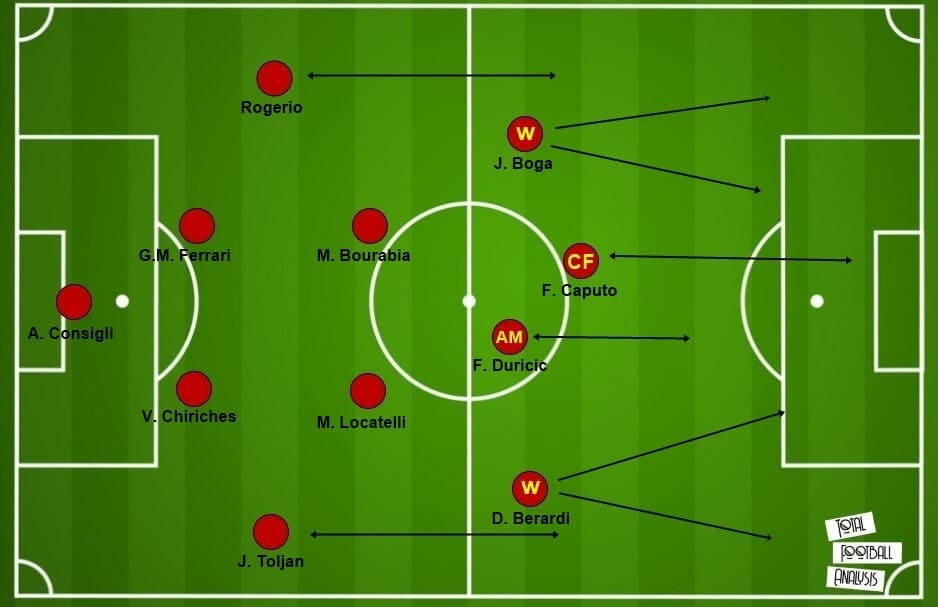
That’s where the double pivot in midfield comes into action. Their positioning is usually very important for breaking through the opposition’s press, meaning they always aim to move between the lines and stay behind their opponents’ first line of defence. This way, they have a better chance to open the passing lanes and help with ball progression. That opportunity comes from the team’s strategy of inviting pressure in their own half and engaging the opposite players, which often results in gaps in midfield that they could exploit. That also gives them the opportunity to create a numerical advantage in the advanced areas.
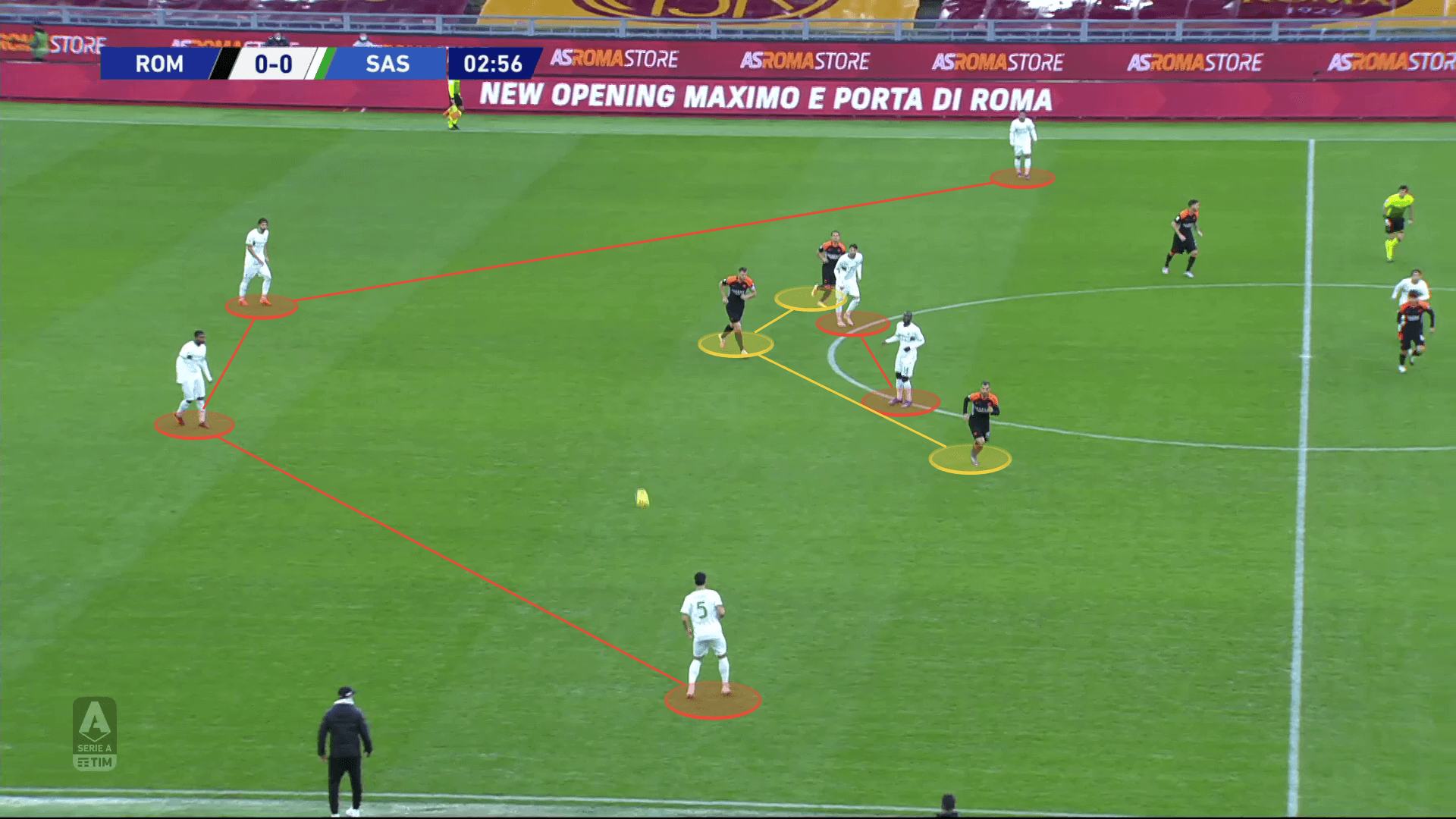
The midfielders would constantly combine with the centre-backs using one-touch pass combinations in efforts to break the lines. They aim to drag players out of position and find pockets that they can use to advance the ball. Then, the attacking players would get the chance to use their skills and penetrate.
Final third actions and the inverted wingers use
Sassuolo’s usual set-up consists of a striker supported by an attacking midfielder from behind and two wide players who would most frequently act as inverted wingers. De Zerbi believes in putting the most effort into the attacking actions and often employs as many players to the opposition half as possible. Sassuolo are among the teams with the most completed passes to the final third, which allows them to create a lot of opportunities throughout the games.
The team only used the width provided by the wingers to initiate a lot of movement and combinations in the final third rather than for crossing. Their last position in Serie A also underlines that in terms of crossing frequency. De Zerbi relies on the wingers to cut inside and help create movement in the penalty area. That brings more options in front of the goal and allows them both to create a direct threat or act as a passing outlet.
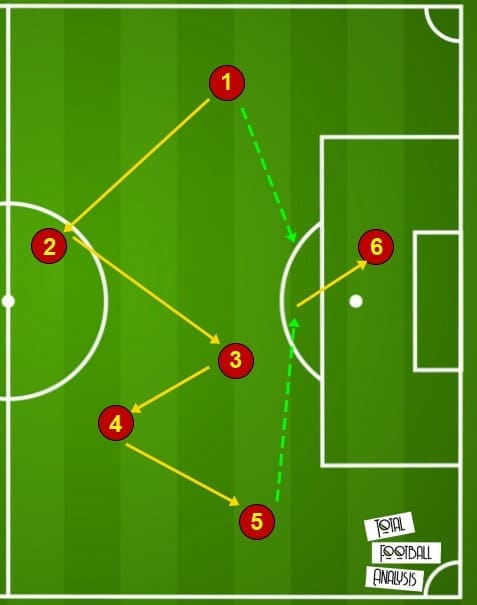
The team rely on dribbling attempts, too, in an effort to hold on to the ball and break through defences. The main ones responsible for that are the wide players Domenico Berardi and Jeremie Boga, who bring more explosiveness with their ball control and help the team be more efficient in the final third.
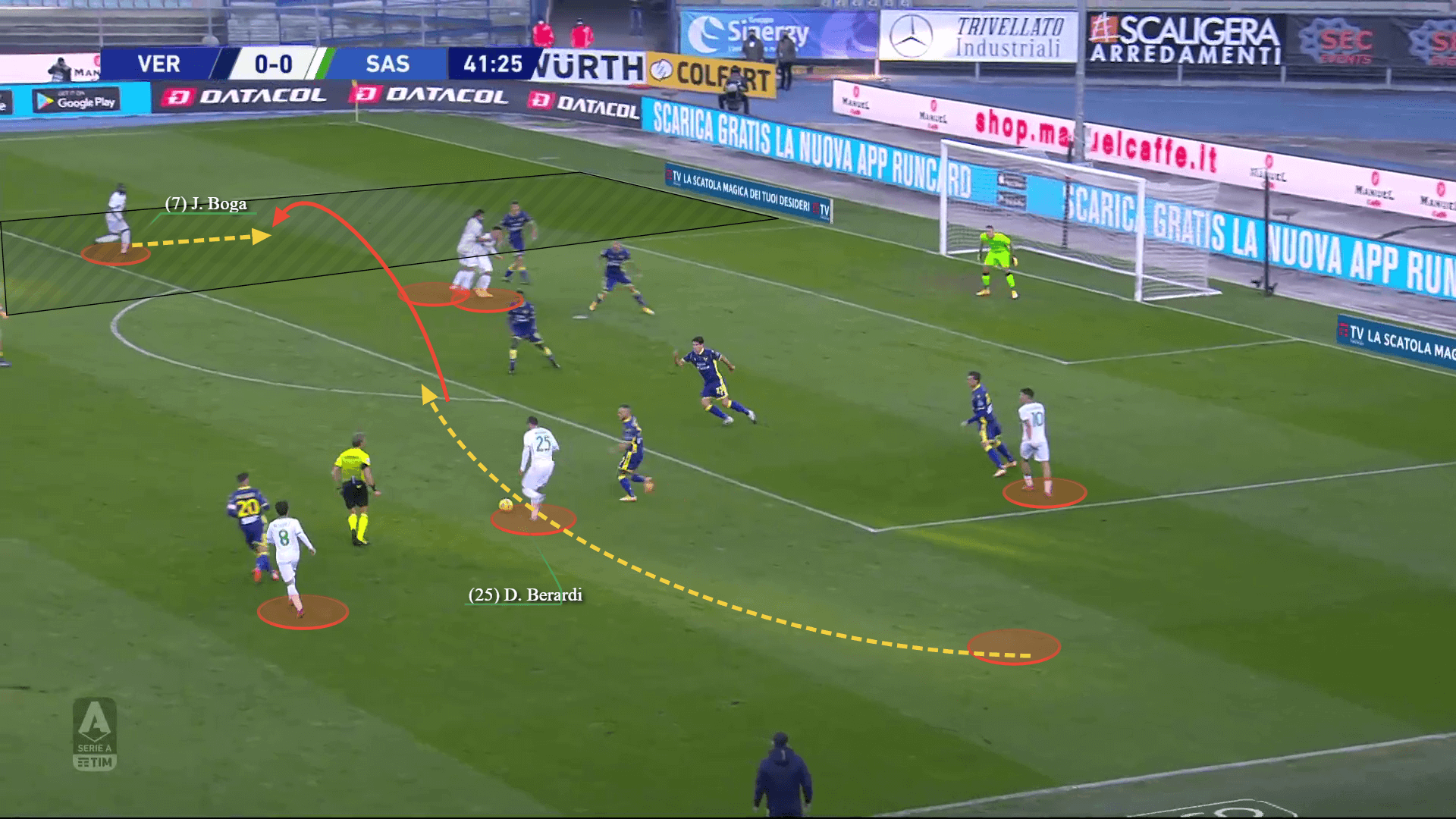
Sassuolo have been overperforming their xG of 11.51, scoring 18 goals so far in their league journey. What makes their attacking actions successful is the high number of shooting efforts (13.74 per 90), which come both from outside the box and from a close distance. That increases their versatility in the advanced areas and helps them break through different defensive structures.
The main player responsible for the actions in front of the goal is Ciccio Caputo, who has turned into one of the most consistent strikers in Italy in the last few years. Caputo’s intelligent movement in the penalty area has made him a crucial part of De Zerbi’s successful attacking strategy. The 33-year-old smartly anticipates both his teammates’ and the opposition’s movement, which makes him very efficient in front of the goal.
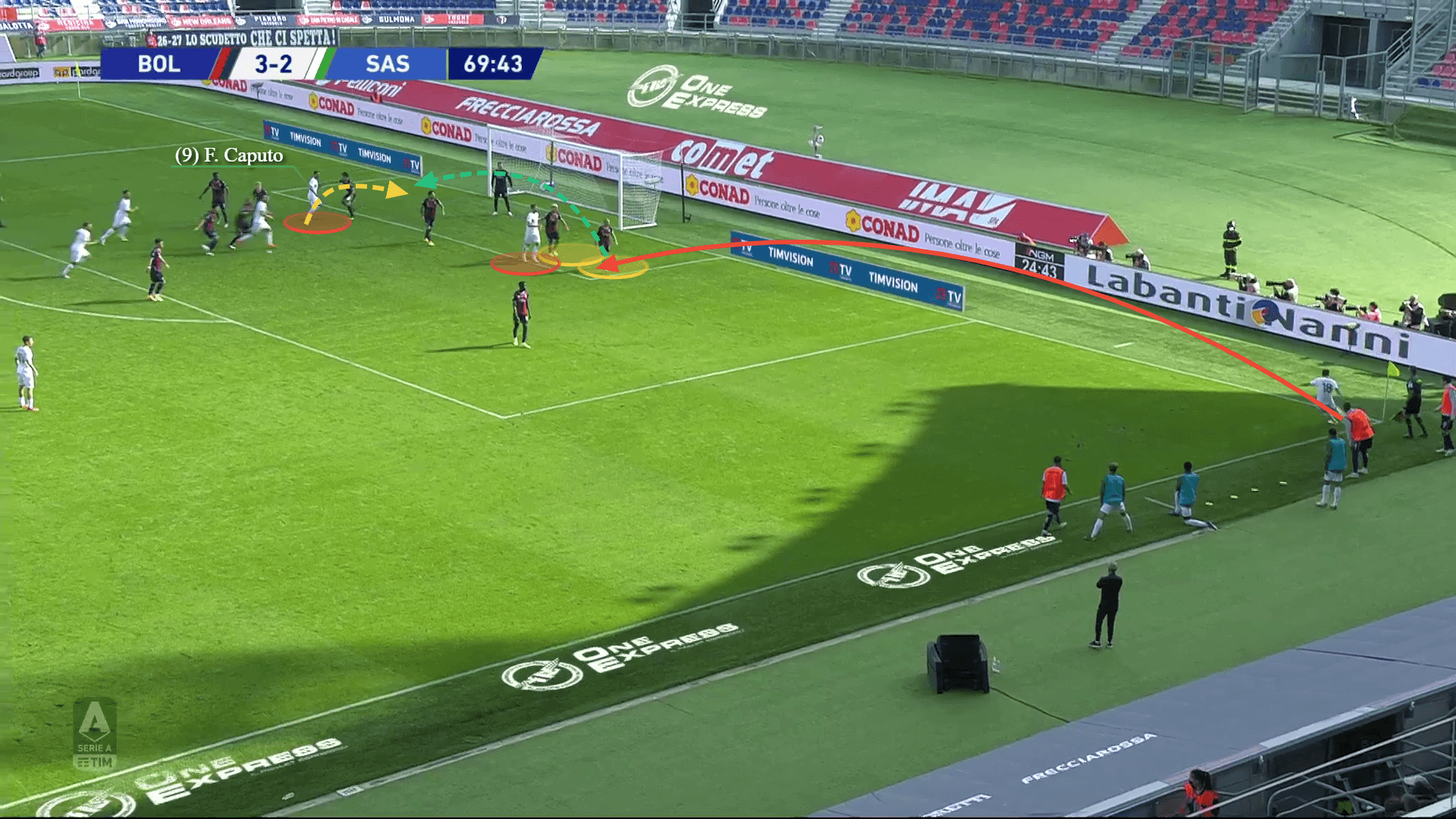
Set-play routines
Sassuolo has been successful in their attacking set-pieces so far, scoring three goals and constantly creating threats by focusing on headshots. While there’s nothing to, Sassuolo has been successful in their attacking set-pieces so far, scoring three goals and constantly creating threats by focusing on headshots. While there’s nothing too distinguished about their free-kick routines, they do have two main strategies in terms of attacking corners.
They either played it short while committing four/five players to the box, or they did play it directly to the penalty area and relied on strong positioning and overcrowding the danger areas. What doesn’t change no matter which routine they use is the two-man coverage outside the box. They always have two players outside the penalty area to cover both second balls and also protect the team in case a counter-attack occurs.
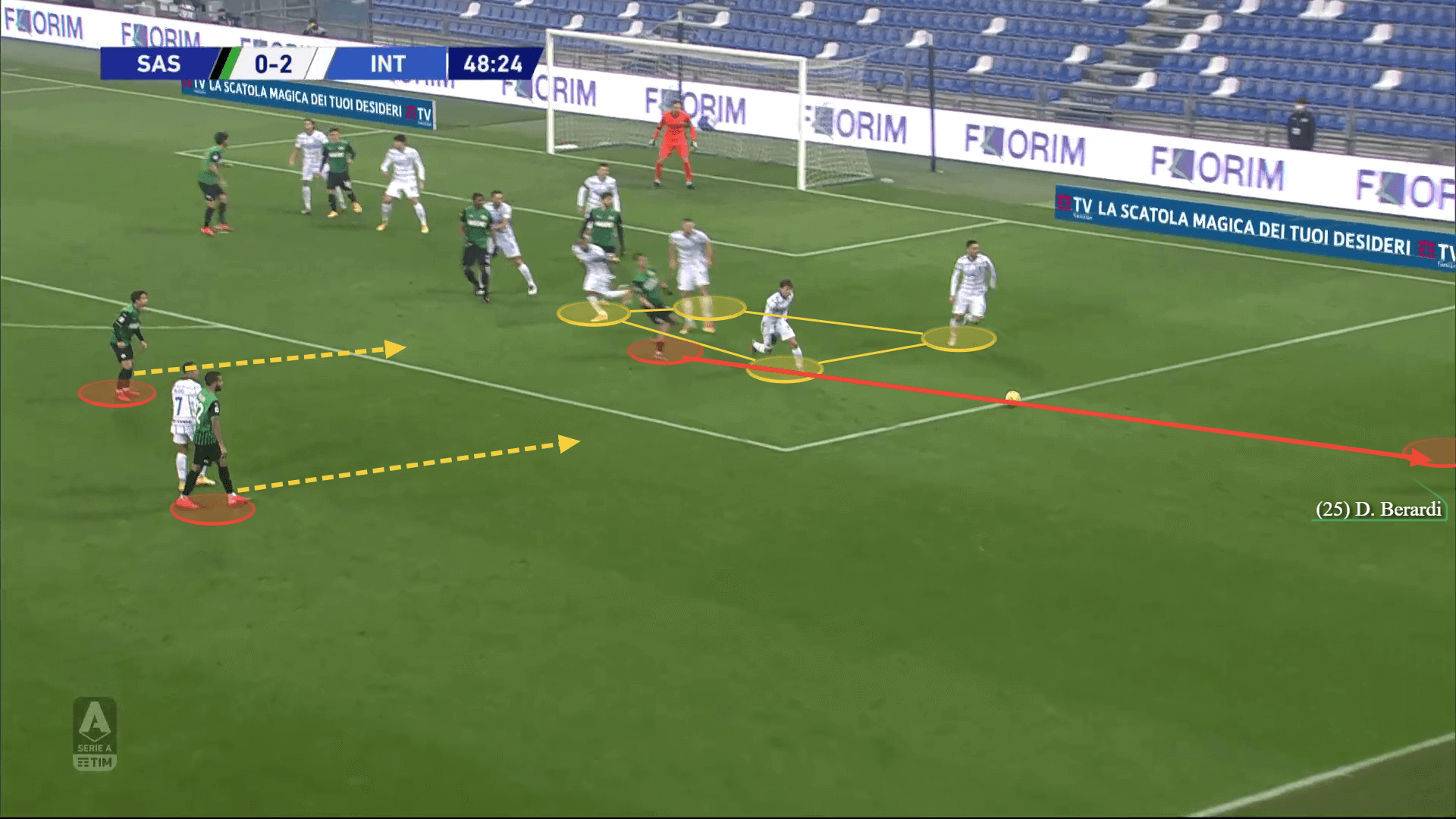
However, they usually rely on aerial dominance in the box, and if their plans fail, they still try to keep the possession by spreading back out to the corner taker, dragging players out of position and exploiting the gaps afterwards.
Defensive transitions and pressing efforts
As happens with most attack-minded teams, their over-commitment to the advanced areas often comes at the expense of their defensive performance. Focusing on the attacking actions and occupying the opposition’s half often results in easily being exposed on a counter. It often leaves empty spaces and causes defensive disorganisation, making it harder for the teams to employ their marking strategy and defensive structure.
Sassuolo is no stranger to these issues, although De Zerbi tactics has clearly shown that he relies on scoring more than the opposition. That wouldn’t always work, but it keeps his team on the front foot and keeps their enthusiasm to keep on scoring.
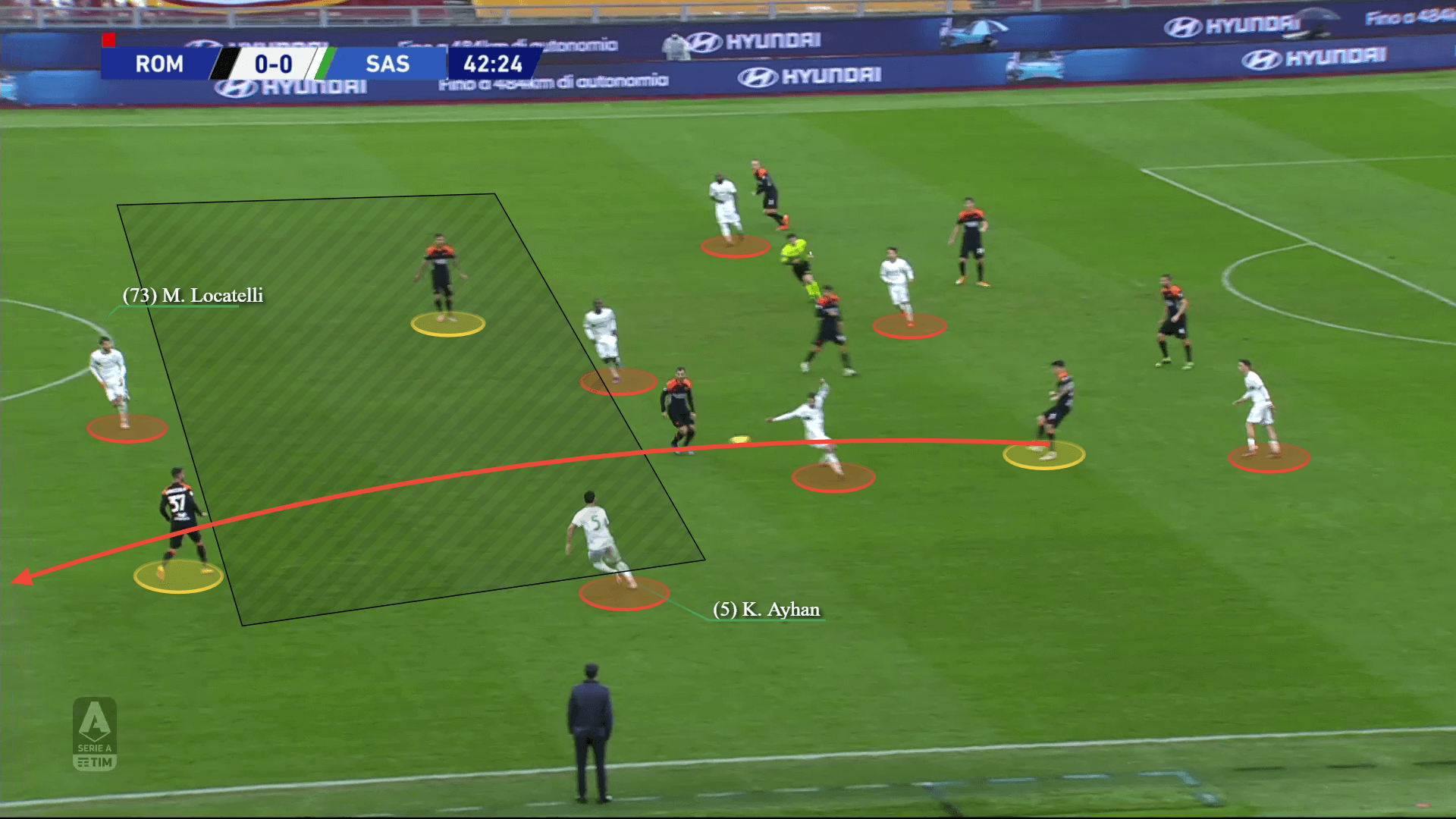
Whenever they need to trouble their opponents’ build-up, they do try to press in the advanced areas but don’t get carried away in pressing too high. Berardi, Locatelli and Filip Đuričić are the players that put effort into recovering the ball on the edge of the final third most frequently.
They also aim to intercept the ball occasionally, trying to keep the ball out of their defensive third. While their movement back when caught on a counter isn’t that well-measured, they are pretty successful in their physical challenges and win a high percentage of their defensive duels. What’s even more impressive is the low number of committed fouls. That helps them steal the ball from the opposition and transition into attack as quickly as possible.
Their pressing strategy is quite intense, and they don’t allow a lot of time on the ball to their opponents. That is confirmed by their PPDA of 8.88, meaning they almost immediately rely on defensive actions and don’t allow a lot of space for movement to their opponents before they try to gain back possession. They are fifth in Serie A in terms of high press intensity, with the champions, Juventus, staying right behind them with a much higher PPDA of 11.07.
That’s another proof of De Zerbi’s aggressive attacking approach and possession football, which is often the reason for their high average possession percentage of 60.4%. After Inter, Sassuolo are the team that holds on to the ball for the longest time per possession on average (19.2 seconds).
As mentioned, Sassuolo are defensively vulnerable, but that comes mainly from their advanced positioning rather than their actions in their own half. Many of their opponents are being pressured to switch to direct play which isn’t beneficial for Sassuolo’s defensive actions since their high positioning leaves gaps between the lines which the oppositions’ attackers could exploit.
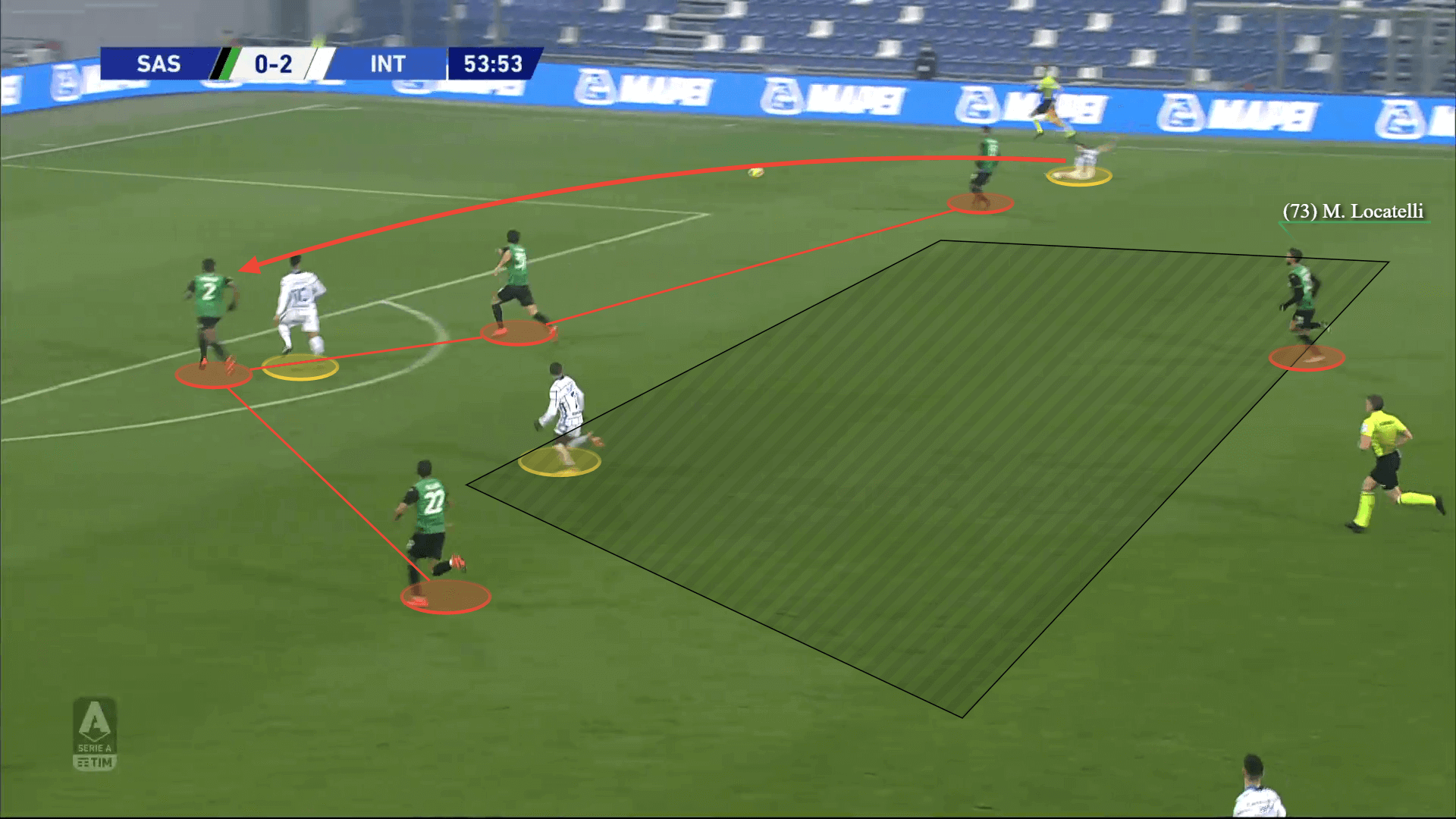
Due to the time needed for the backline to organise during defensive transitions, the midfielders are often forced to dive into challenges midway to stop their opponents from creating chances. That’s the reason why Locatelli averages 1.44 sliding tackles per game.
Defensive third and penalty area actions
Sassuolo’s struggles in their defensive third most frequently come from gaps occurring on the flanks. While the full-backs wouldn’t go as high up as usual with his formation, they do often go past the central line which affects their defensive performance immensely since they occasionally fail to drop back in a timely manner and also there’s rarely someone to cover depth
That exposes them to conceding crossing attempts and increasing the danger in the box, where, luckily, they have better success in their positioning and challenges. They rarely lose the ball in the penalty area which has helped them in conceding only nine goals since the start of the season.
They put efforts in their aerial presence when defending in the box, but that’s something they could improve on since they often fail in their attempts which increases the risk of conceding. Their overall success rate in aerial duels is higher than the average in the league but their efficiency decreases under pressure.
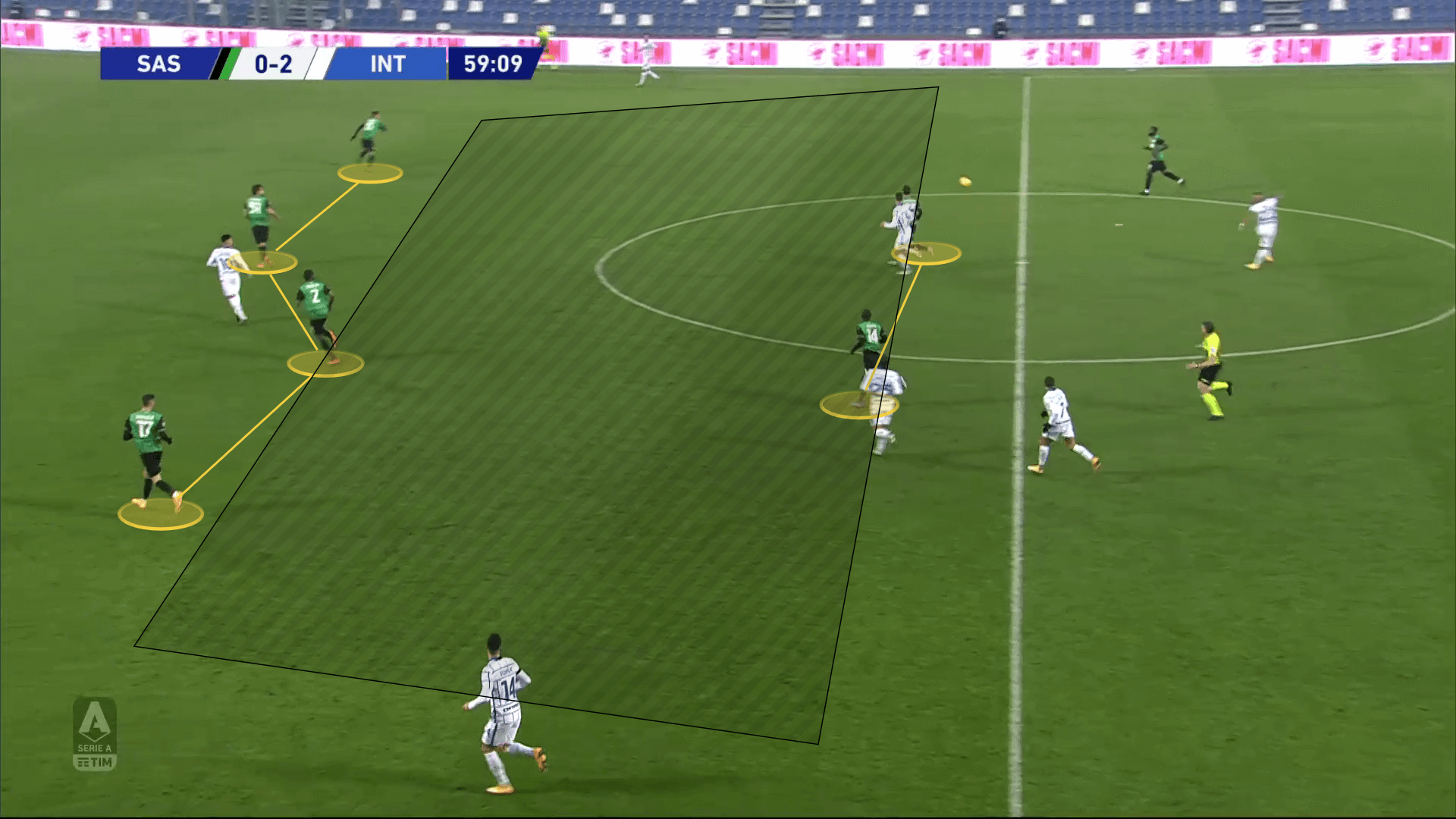
Final thoughts
Roberto De Zerbi undoubtedly is one of the most promising coaches in modern football and his philosophy is transforming Sassuolo into opponents that no one should underestimate.
The team have the advantage of focusing only on their Serie A actions, which could be crucial in the Serie A title race since they only have to commit to one game per week.
At the same time, some of the other contenders have to focus on their European contributions too.

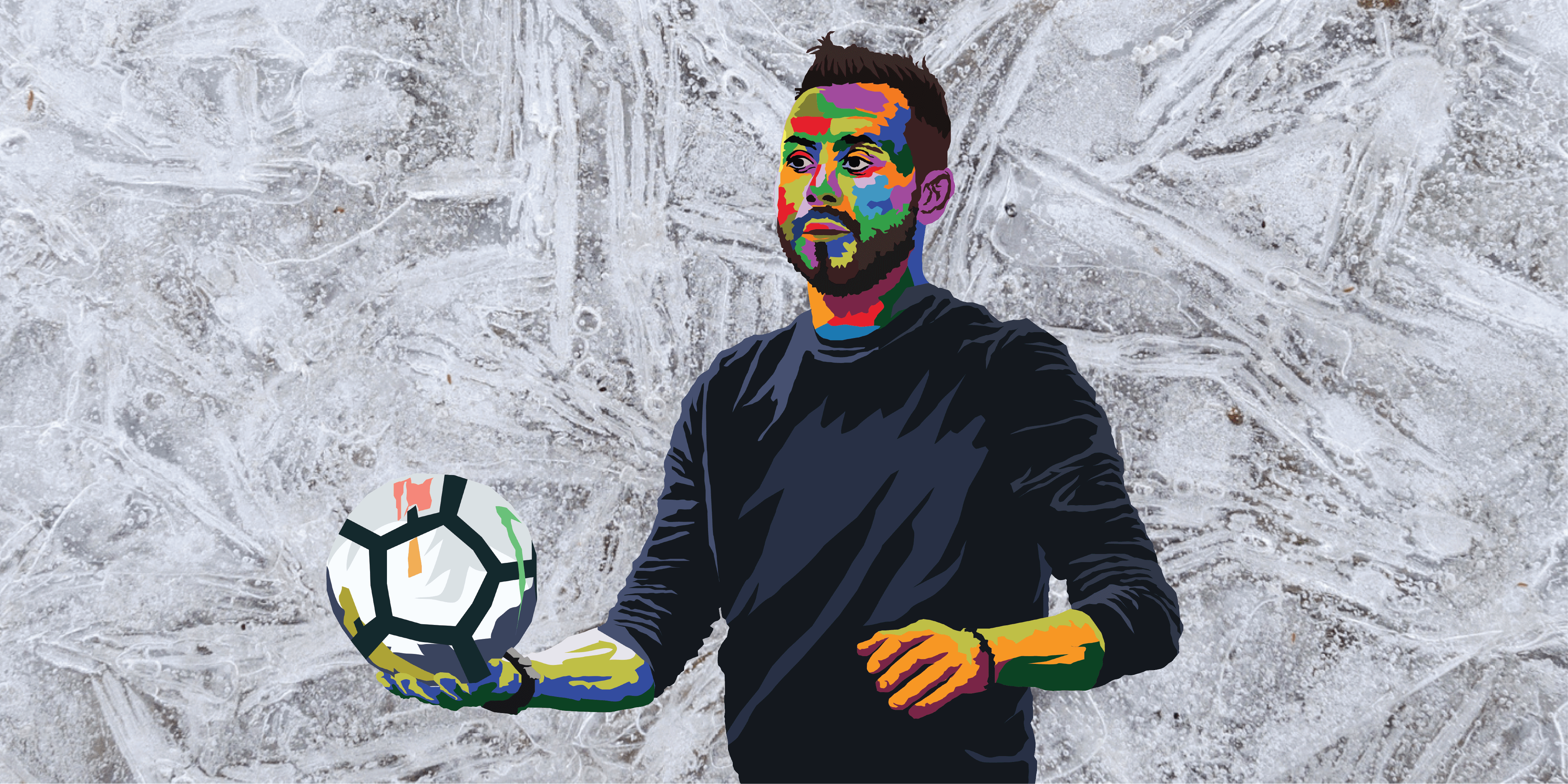



Comments